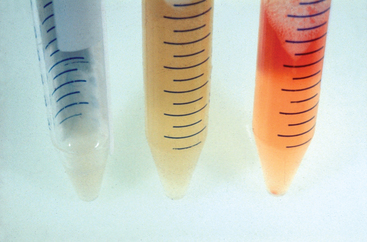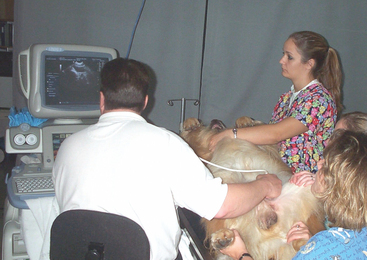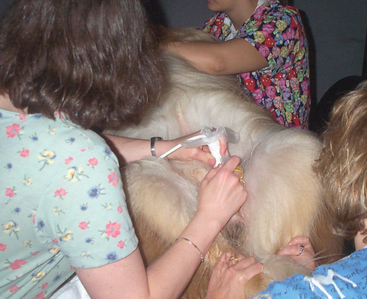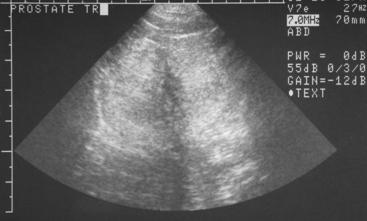26 Disorders of the Prostate
The prostate encircles the neck of the urinary bladder such that the urethra runs directly through the center. There are two prostatic lobes, separated by fibrous tissue. Growth and function of the prostate are androgen dependent. Under the influence of testosterone and its metabolite, dihydrotestosterone (DHT), prostatic cells increase in number (hyperplasia) and size (hypertrophy). As long as a male dog is intact, progressive increase in prostate size will occur. Castration causes profound prostate atrophy.
The following are diagnostic tests used for identification of all types of prostatic disease:
I. BENIGN PROSTATIC HYPERTROPHY/HYPERPLASIA
D. DIAGNOSIS
Diagnosis may be made based solely on rectal palpation of the prostate and submission of semen for cytology and culture. Semen color may be abnormal (Figure 26-3). Imaging and aspiration of the prostate may be performed (Figure 26-4 and Table 26-1).

Figure 26-3 Variations in semen color in dogs with benign prostatic hyperplasia.
(Courtesy Dr. Kaitkanoke Sirinarumitr.)
Table 26-1 Diagnostic Test Results in Dogs with Benign Prostatic Hyperplasia
| Diagnostic Test | Result and Interpretation |
|---|---|
| Rectal palpation | Symmetrical, nonpainful. The prostate may be so enlarged as to pull the urinary bladder into the abdomen. The enlarged prostate may be palpable per abdomen. |
| Semen collection | Color of prostatic fluid varies from clear to tan to maroon (Figure 26-3). |
| Prostatic radiographs or ultrasound | Contrast radiographs demonstrate forward movement of the bladder and flattening of the back of the usual teardrop-shaped urinary bladder by presence of the enlarged prostate. On ultrasound, the prostatic tissue is uniform (Figure 26-4). |
| Aspirate or biopsy | Normal cells are present. There are no inflammatory changes. |
E. TREATMENT
In dogs with no clinical signs of disease, no treatment may be necessary. If treatment is required, castration is the best therapy, causing the quickest and most complete prostate atrophy. If castration is undesirable, medical therapy with the human drug finasteride (Proscar or Propecia) may be used to decrease prostate size. Finasteride is administered daily for 1 to 4 months. A significant decrease in prostate size and coincident clinical signs occurs within 4 to 6 weeks of therapy in most dogs. After withdrawal of the drug, the prostate gradually will increase in size again. Treatment of dogs with finasteride is not associated with decline in semen quality. Breeding of dogs on finasteride has not been associated with small litter size or induction of birth defects in pups. Other therapies described for use in humans, such as the use of the herb saw palmetto, have not been demonstrated to be useful therapies for BPH in dogs. Other hormone therapies, including use of progesterone or estrogen, have been described for use in dogs but may have undesirable side effects.
< div class='tao-gold-member'>
Stay updated, free articles. Join our Telegram channel

Full access? Get Clinical Tree





